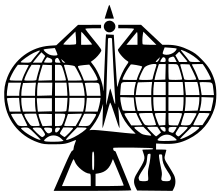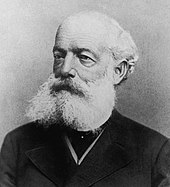 | |
 IUPAC標誌 | |
| 原名 | International Union of Pure and Applied Chemistry |
|---|---|
| 簡稱 | IUPAC |
| 成立時間 | 1919年 |
| 類型 | 國際組織 標準組織 |
| 總部 | 瑞士蘇黎世和北卡羅萊納州三角研究園 |
| 服务地区 | 全球 |
官方語言 | 英語 |
主席 | |
副主席 | |
秘书长 | |
| 標語 | 促進全球化學進步 |
| 網站 | iupac |
國際純化學和應用化學聯合會(International Union of Pure and Applied Chemistry,IUPAC)简称国际化联,又譯國際純粹與應用化學聯合會、国际纯化学与应用化学联盟、國際純化學與應用化學協會、国际理论与应用化学联合会或国际理论与应用化学联盟,是一個聯合國家會員組織,代表各國化學家的國際聯盟,属國際科學理事會(ISC)的成員之一[1]。IUPAC的國際總部設於瑞士蘇黎世;其行政辦公室,或稱IUPAC秘書處,位於美國北卡羅萊納州的三角研究園。這所行政辦公室由IUPAC的理事長帶領[2]。截至2012年8月1日的理事長為John D. Petersen博士[3]。
IUPAC於1919年成立,前身為“國際應用化學大會”,國家會員組織[4](National Adhering Organization)[5]為其成員,可以是國家的科學學會、科學研究所,以及任何其他代表化學家的組織。成員包括54個設國家會員組織以及3個聯繫會員[1]。IUPAC跨部門的命名及符號委員會(IUPAC命名法)是建立化學元素及化合物命名標準的國際權威。自從創立以來,IUPAC由多個委員會運行,各有其能[6]。這些委員會分別進行不同的計劃,包括統一命名[7]、向世界推廣化學[8]以及出版文獻。[9][10][11]
IUPAC以統一規範化學等領域的命名而著稱,但它也同時有多項涉及化學、生物學及物理學的出版物[12]。其中重要的貢獻包括:對核酸基序列碼的規範化,出版有關環境科學、化學和物理學的文獻,以及帶領增強科學教育[12][13]。
統一規範化學命名
[编辑]
元素命名的決定不斷變化,混雜了人類各種語言、文化、及對化學知識的理解[14]。化學元素的名稱隨著歷史演進有不同來源,有從古代就有名稱的、有採用鍊金術師時代名稱的、有採用神話的、有採用顏色的、有按地理名稱取的、有按元素性質取名的、也有按人名取名的[15]。在現代慢慢接受發現者有權命名,然而國際純粹與應用化學聯合會(IUPAC),對於元素命名和符號有最終決定權[15]:72。
從1947年起,IUPAC負起批准元素名稱的責任,並為每一個元素決定國際通用的單一符號。在此之前,有不少元素有多個名字,如元素41铌的名字在歐洲和美洲間存有爭議150年,在1949年,IUPAC決定採歐洲使用的名稱[14]。截至2015年[update],IUPAC治理全球化學知識,成為化學元素新發現及命名權的最終裁決法院,創立了國際認可的標準術語,這是在19世紀所明顯沒有的[16]。
成立與歷史
[编辑]
由德國科學家弗里德里希·奧古斯特·凱庫勒·馮·斯特拉多尼茨帶頭的一個委員會在1860年首次探討有關需要一個國際化學標準的問題。該委員會進行了世界首次有關國際有機化合物命名系統的會議[12]。會議中的思想最終演化成為正式的IUPAC有機物命名法[12]。IUPAC是這次會議的成果,因此也是國際化學學會之間歷史上最重要的合作之一[12]。從此,IUPAC擔起了更新及維護有機物命名法的重責[17]。IUPAC就此在1919年成立了[18]。最初的IUPAC並沒有包括德國,這是由於同盟國在第一次世界大戰後對德國持有偏見[19]。德國最終於1929年進入IUPAC,但納粹德國在第二次世界大戰期間再被逐出IUPAC。
二戰期間,IUPAC與同盟國保持著關係,但對戰事本身參與不多。戰後,西德被允許重返IUPAC[19]。從二戰至今,IUPAC持續不間斷地對命名及科學方法規範化,沒有受到更多的阻礙。
委員會與治理
[编辑]IUPAC由多個委員會治理,各有其不同的責任。委員會有:理事會、適應世界需求的化學研究委員會(CHEMRAWN)、化學教育委員會、化學與工業委員會、印刷及電子出版物委員會、評估委員會、執行委員會、財務委員會、跨部門術語、命名及符號委員會、項目委員會、以及純粹與應用化學編委[6]。每個委員會都由各國的會員組織組成[1]。
IUPAC的指導委員會架構如下:[10]
- 所有委員會需遵循為其分配的預算。
- 任何委員會都可以開始一個項目或計劃。
- 一旦項目超出委員會的預算,該問題必須提交到項目委員會。
- 項目委員會將提高預算,或尋找外來資金。
- 理事會及執行委員會監督著其他委員會的運作。
| 委員會名稱(縮寫) | 責任 |
|---|---|
| 理事會 |
|
| 適應世界需求的化學研究委員會(CHEMRAWN) |
|
| 化學教育委員會(CCE) |
|
| 化學與工業委員會(COCI) | |
| 印刷及電子出版物委員會(CPEP) | |
| 評估委員會(EvC) |
|
| 執行委員會(EC) |
現任執行委員會委員:
|
| 財務委員會(FC) |
|
| 跨部門術語、命名及符號委員會(ICTNS) | |
| 項目委員會(PC) |
|
| 純粹與應用化學編委(PAC-EAB) |
國際化學年
[编辑]
IUPAC和聯合國教科文組織是國際化學年(2011年)有關活動的主辦組織[27][28]。IUPAC於意大利都靈的大會上首次提出舉辦國際化學年[29]。聯合國教科文組織於2008年接受動議[29]。國際化學年的宗旨為提高公眾對化學的興趣及欣賞,同時鼓勵年輕人參與及為化學作貢獻。另外活動也回看化學如何大大提高了人們的生活[13]。
目前的項目
[编辑]IUPAC項目列表
[编辑]- 項目號2009-012-2-200:配位聚合物及金屬-有機骨架:術語及命名法指引[30]
- 項目號2009-032-1-100:為鹵素化學鍵和其他鹵素原子的非共價鍵交互作用進行歸類。[32]
- 該計劃的目標是為鹵素成鍵反應進行定義,並為鹵素的分子交互作用分類。[33]
- 項目號2009-048-1-600:為土壤和地表水源的環境物質監測作指引。[32]
- 項目目的為辨認新型污染物及其危害,並監測以前較少研究的污染物。另外,項目也會提供如何監測污染物的策略,並探討各種監測方法的利弊。[34]
- 項目號2009-034-2-700:研究鎘對人體健康的威脅。[32]
- 該項目旨在辨認人體在暴露在鎘之後的危害及反應。鎘目前在國際癌症研究中心列為致癌物。另外,項目也會研究鎘是如何進入人體的。[35]
- 項目號2009-019-2-400:體積排阻色譜法等聚合物表徵法中的資料處理。對譜帶增寬等誤差來源的矯正。[32]
- 該項目旨在為聚合物表徵和測量提供準確度更高的實際方法。這能夠幫助體積排阻色譜法等聚合物表徵法實驗工具的製造商製造出更精確的產品。[32]
參見
[编辑]- CAS號
- 国际纯粹与应用物理学联合会(IUPAP)
- 國際生物化學與分子生物學聯盟(IUBMB)
- 國際化合物標識(InChI)
- 簡化分子線性輸入規範(SMILES)
- 國家標準技術研究所(NIST)
- IUPAC命名法
參考資料
[编辑]- ^ 1.0 1.1 1.2 IUPAC National Adhering Organizations. Iupac.org. 2 June 2011 [8 June 2011]. (原始内容存档于2011年6月4日).
- ^ IUPAC Council Agenda Book 2009 (PDF). IUPAC. 2009 [17 April 2010]. (原始内容存档 (PDF)于2012-03-09).
- ^ 存档副本. [2012-12-06]. (原始内容存档于2012-12-14).
- ^ 存档副本. [2022-11-30]. (原始内容存档于2022-11-30).
- ^ 存档副本. [2022-11-30]. (原始内容存档于2023-03-14).
- ^ 6.0 6.1 IUPAC Committees list (页面存档备份,存于互联网档案馆) retrieved 15 April 2010
- ^ 7.0 7.1 Interdivisional Committee on Terminology web page (页面存档备份,存于互联网档案馆) retrieved 15 April 2010
- ^ 8.0 8.1 Chemdrawn (页面存档备份,存于互联网档案馆) retrieved 15 April 2010
- ^ 9.0 9.1 Pure and Applied Chemistry Editorial Advisory Board web page (页面存档备份,存于互联网档案馆) retrieved 15 April 2010
- ^ 10.0 10.1 10.2 Project Committee web page. Iupac.org. 2 June 2011 [8 June 2011]. (原始内容存档于2011年6月29日).
- ^ 11.0 11.1 Evaluation Committee page (页面存档备份,存于互联网档案馆) retrieved 15 April 2010
- ^ 12.0 12.1 12.2 12.3 12.4 Fennel, R.W. History of IUPAC, 1919–1987. Blackwell Science. 1994. ISBN 0-86542-8786.
- ^ 13.0 13.1 IYC: Introduction. (页面存档备份,存于互联网档案馆) 9 July 2009. Retrieved on 17 February 2010. Retrieved 15 April 2010
- ^ 14.0 14.1 Christopher Brooks. The periodic table: how elements get their names. BBC Science. 14 November 2013 [2015-05-22]. (原始内容存档于2015-02-16).
- ^ 15.0 15.1 Per Enghag. The Elements- Origin, Occurence, Discovery And Names(元素 - 起源、出现、發現及名稱). Encyclopedia of the Elements: Technical Data - History - Processing - Applications(元素百科全書:技術資料 - 歷史 - 加工 - 應用). John Wiley & Sons. 8 January 2008: 55–78. ISBN 978-3-527-61234-5 (英语).
- ^ Michael D. Gordin. Scientific Babel How Science Was Done Before and After Global English. University of Chicago Press. 13 April 2015: 178–180. ISBN 978-0-226-00029-9 (英语).
If the Boycott of German scholars from conferences was the short-term punishment for perceived misdeeds during the war, the IRC's second action would have more lasting consequences for the fate of German as a scientific language. ... To this day, IUPAC governs global chemistry, serving the court of final recourse to adjudicate discovery claims of new elements (and the right to name them, thus creating the internationally recognized standard nomenclature that had been noticeably lacking in the nineteenth century). Like many of these organizations, IUPAC was actually a reactivation of a prewar institution -in this case, the International Association of Chemical Societies, proposed in 1910 by Wilhelm Ostwald and Albin Haller, president of the French Chemical Society -but now with the Germans excluded. Cutting out the Germans implied cutting out German. German had been an official language, with English and French of the International Association; it was just obvious to the IRC's movers and shakers that it would not be permitted at IUPAC. Concern over the dominance of German, especially within chemistry, had been simmering for some time. ... In all these international venues, German was proscribed, and only (alongside Italian) granted a subsidiary status in IUPAC in 1929. ... In 1932, for example, French was permitted as an official language at 351 (98.5%) of the international conferences that year, and English was 298 (83.5%). The boycott being over, German was officially permitted at 60.5% -nothing to sneeze at, but a far cry from the parity one would have expected in the prewar years.
- ^ Brown, Theodore L.; H. Eugene LeMay Jr, Bruce E Bursten. Chemistry The Central Science Tenth Edition. Pearson Books. 2006. ISBN 0-13-109686-9.
- ^ 存档副本. [2013-03-11]. (原始内容存档于2012-12-14).
- ^ 19.0 19.1 Kaderas, Brigitte. Wissenschaften und Wissenschaftspolitik: Bestandsaufnahmen zu Formationen, Brüchen und Kontinuitäten im Deutschland des 20. Jahrhunderts. Franz Steiner Verlag. 2002. ISBN 3-515-08111-9 (德语).
- ^ IUPAC news and references (页面存档备份,存于互联网档案馆) retrieved 15 April 2010
- ^ Chemistry Education (页面存档备份,存于互联网档案馆) retrieved 15 April 2010
- ^ Chemistry and Industry (页面存档备份,存于互联网档案馆) retrieved 15 April 2010
- ^ Committee on Electronic and Printed Publications webpage (页面存档备份,存于互联网档案馆) retrieved 15 April 2010
- ^ Executive Committee meeting[永久失效連結] retrieved 15 April 2010
- ^ Executive Committee Page (页面存档备份,存于互联网档案馆) retrieved 15 April 2010
- ^ Finance Committee web page (页面存档备份,存于互联网档案馆) retrieved 15 April 2010
- ^ United Nations Resolution 63/209: International Year of Chemistry. (页面存档备份,存于互联网档案馆) 3 February 2009. Retrieved on 24 April 2010.
- ^ About IYC: Introduction. (页面存档备份,存于互联网档案馆) 9 July 2009. Retrieved on 24 April 2010.
- ^ 29.0 29.1 International Year of Chemistry Prospectus. Portal.acs.org. [8 June 2011]. (原始内容存档于2011年11月5日).
- ^ IUPAC Current Projects. (页面存档备份,存于互联网档案馆) 9 May 2010. Retrieved on 9 May 2010.
- ^ CP and MOF Project. (页面存档备份,存于互联网档案馆) 9 May 2010. Retrieved on 9 May 2010.
- ^ 32.0 32.1 32.2 32.3 32.4 IUPAC Current Projects. (页面存档备份,存于互联网档案馆) 15 February 2010. Retrieved on 17 February 2010.
- ^ Halogen Bonding Project. (页面存档备份,存于互联网档案馆) 15 February 2010. Retrieved on 17 February 2010.
- ^ IUPAC Current Projects. (页面存档备份,存于互联网档案馆) 15 February 2010. Retrieved on 2 March 2010. Retrieved 15 April 2010
- ^ IUPAC Current Projects. (页面存档备份,存于互联网档案馆) 15 February 2010. Retrieved on 2 March 2010.
外部連結
[编辑]- 官方网站
- Panel on Biochemical Thermodynamics. Recommendations for nomenclature and tables in biochemical thermodynamics. G. P. Moss, Queen Mary University of London. 1994 [2013-01-12]. (原始内容存档于2017-09-13).








